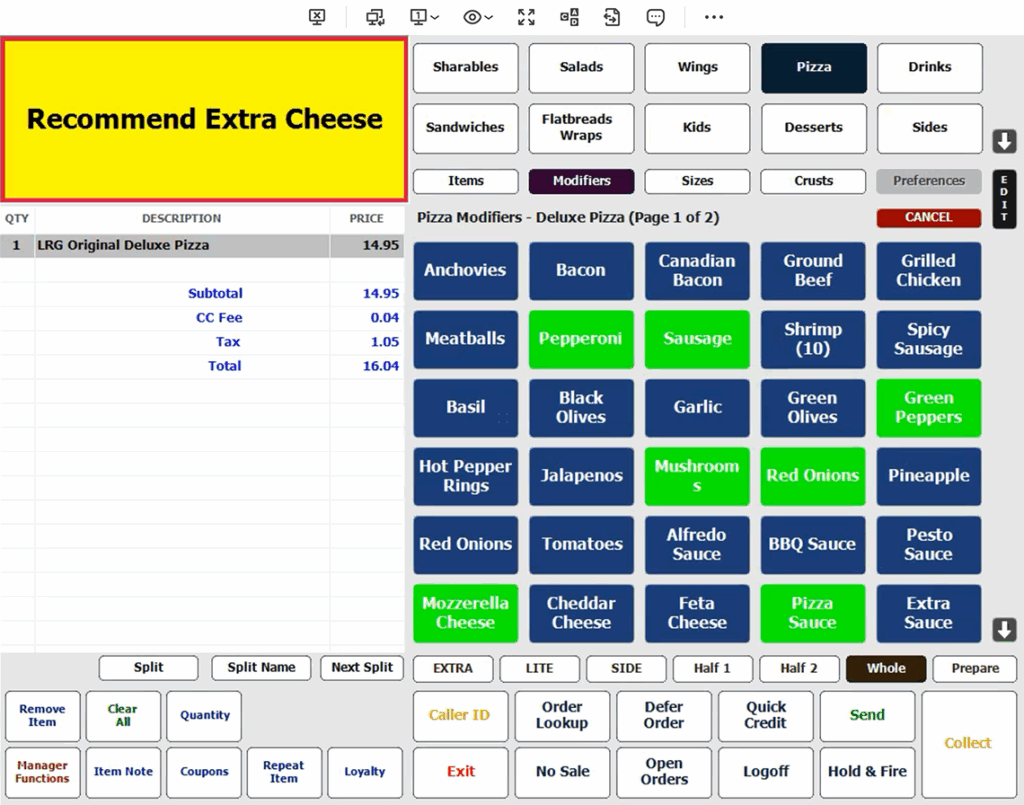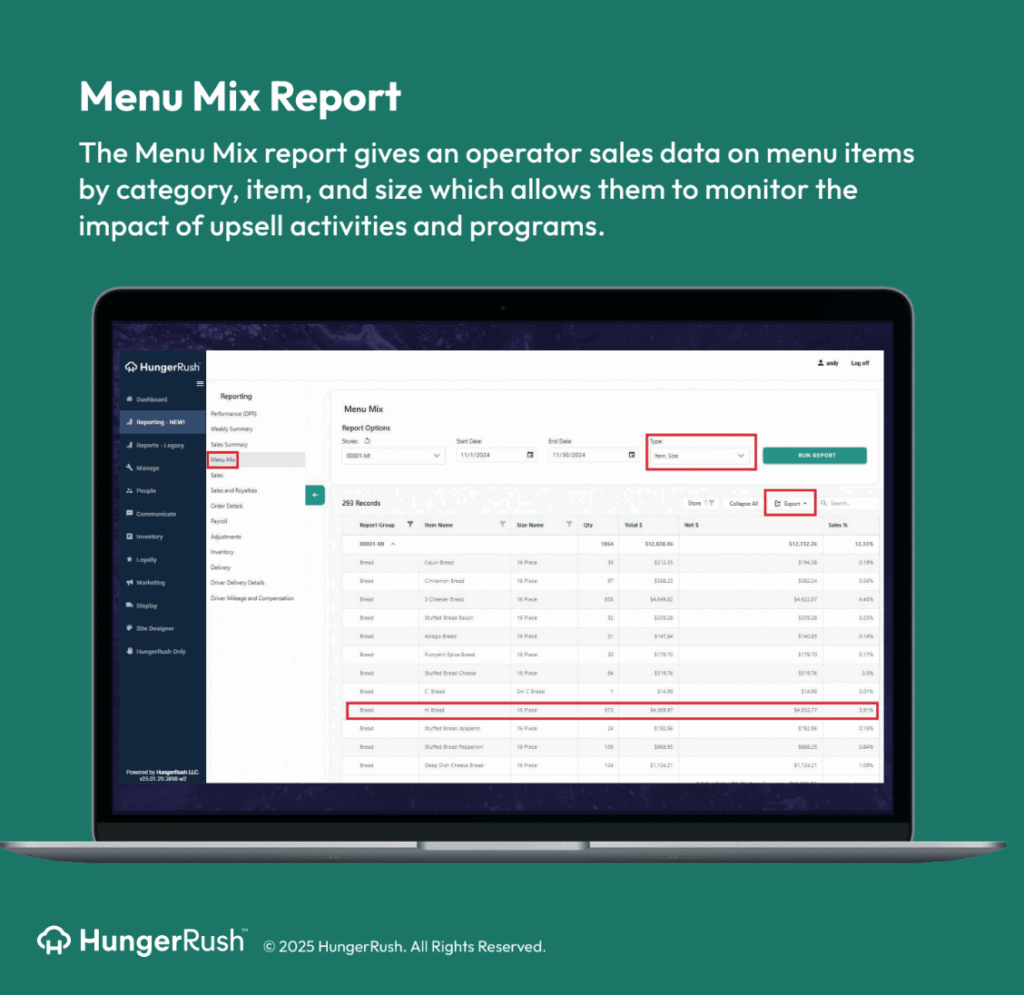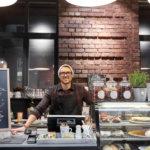A version of this essay appears in Bill Mitchell’s Restaurant Leader’s Playbook.
Want to get the full step-by-step guide for transforming restaurant operations?
By Bill Mitchell, HungerRush CEO
Restaurant Upselling Basics
Part of a successful restaurant upselling strategy is a shift in how you think about the upsell. Upselling isn’t just about asking customers to spend more, it’s about offering them opportunities to enhance their experience in ways that add value for them and profitability for you. When done right, upselling is seamless and data-driven, and when consistently implemented across all locations, could add significant revenue annually.
The key to a successful upsell for the guest is that it complements their order. Cheesy French fries with a burger, soda with wings and a pizza. For the business, success comes from triangulating order frequency, cost of goods, and labor cost. When the frequency is high (guests often choose the upsell), and the cost is low (creating a higher margin) it’s a win-win.
For example, if 70% of guests accept an upsell and the food cost for the item is only 22% (78% profit margin), it’s a clear win.

Once the ideal combination of order and add-on is identified, use technology and training to operationalize the upsell for measurable impact on sales.
To ensure the strategy is effective, store managers and franchise owners need to track results daily. The right POS technology can monitor attachment rates and provide insights within regular reporting, ensuring your upselling strategy becomes a reliable and sustainable driver of revenue.
Leverage Online Ordering for Smarter Upselling
Online ordering platforms are a proven way to boost revenue, driving sales without adding labor costs. There are lots of statistics out there about just how much of a boost can be created by automated prompts for add-ons like drinks, sides, or desserts during checkout, ranging from 5%-30%. The actual percentage will undoubtedly be specific from brand to brand and store to store, but all of the data agree: automated upsells increase average ticket size for digital orders.
By strategically presenting high-margin items at the right moment, online suggestive selling transforms each order into a growth opportunity, delivering scalable, measurable results across all locations.
Why is digital upselling so effective? It’s consistent. And a model of consistent upselling will work in person as well and should be designed and trained across all staff members. Your POS can help you build that in-person consistency.
Train Teams to Upsell with Confidence
A well-trained team is your secret weapon. Upselling should feel natural, like part of excellent hospitality, rather than a sales pitch. For example, Subway has excelled at upselling by training team members to suggest specific, complementary add-ons. Instead of asking, “Would you like anything else?” employees are trained to say, “Would you like to add double meat or cheese to your sandwich?” This targeted approach has helped increase average ticket size while providing customers with options that enhance their meals.
For your team, focus on micro-conversions. Replace vague questions like, “Anything else?” with specific suggestions tied to high-margin items.
For instance, train team members to say, “How about a bag of chips or a cookie to complete your meal?” These scripts create consistency across locations and drive measurable results.
Creating a Culture of Strategic Upselling
Technology alone isn’t enough—successful upselling requires building a culture where team members understand both the how and the why behind the strategy.
The most successful restaurant brands frame upselling as enhancing guest experience rather than simply increasing check averages. When staff believe they’re helping customers discover options that will truly improve their meals, upselling becomes a natural extension of hospitality rather than a forced sales tactic.
To solidify this behavior, team meetings can include discussions of successful upselling moments, with staff sharing stories of positive customer reactions to thoughtful suggestions. These narratives reinforce the connection between upselling and customer satisfaction.
Creating friendly competition around upselling metrics can also drive engagement across multiple locations. Leaderboards displaying top-performing individuals and stores create positive pressure while recognition programs reward those who consistently excel at thoughtful upselling.
Operators should regularly review POS upselling data with team members, highlighting both successes and opportunities. This transparent approach demonstrates the real impact of upselling efforts on the business and helps staff build consistency by understanding which suggestions resonate most strongly with customers.
Training should emphasize active listening to identify genuine upselling opportunities based on customer preferences. Rather than mechanically offering the same add-on to every guest, staff should be encouraged to tailor suggestions based on the specific situation and customer cues.
Monitor and Optimize Upselling Performance
Data doesn’t stop being valuable after implementation. Strong store operators track upselling performance daily, monitoring metrics like average ticket size, high-margin item sales, and time-of-day trends. When a particular upselling tactic underperforms in one region, they adjust and test a new approach immediately.
By implementing a structured upselling plan, you’re not just boosting ticket sizes, you’re ensuring your entire operation runs smarter. This strategy creates a ripple effect: increased profitability, better resource allocation, and scalable sustained growth.
Advanced POS Upselling Features That Drive Revenue
POS systems like the HungerRush POS system now include customizable “smart prompts” that appear at strategic moments during order entry. For example, when a server inputs a burger order, the POS automatically suggests high-margin additions like premium toppings, specialty sauces, or upgraded sides.

These intelligent prompts eliminate the variability of server-initiated upselling, ensuring every customer receives appropriate suggestions regardless of which team member takes their order.
The system also provides performance metrics that allow managers to track which prompts convert most successfully. This data enables continuous refinement of your upselling strategy, focusing on the highest-performing add-ons while phasing out underperforming suggestions.

Implementing POS Systems for Multi-Location Restaurants
For brands operating across multiple locations, building consistency presents both a challenge and an opportunity. The HungerRush POS system is designed for multi-location operations and enables centralized control while allowing for location-specific customization when needed. This allows you to implement uniform upselling protocols across all restaurant locations simultaneously. If your menu analysis uncovers a new high-margin pairing opportunity, you can deploy the corresponding POS prompt to every restaurant, ensuring immediate execution across your entire footprint.
Data from automated upsells can then be used to highlight which locations excel at upselling and which require additional training or support.
You can use the techniques of your all-star locations to build your brand’s own best practices from top-performing stores and implement them across your locations.
Location-specific customization options are equally important. While the core upselling strategy remains consistent, the ability to tailor certain aspects to local preferences or regional specialties can maximize the effectiveness of your strategy. For example, a restaurant in a college town might emphasize late-night dessert upsells, while the same chain’s airport location might focus on grab-and-go item attachments.
Measuring Long-term Impact and Refining Your Approach
The restaurant landscape is constantly evolving. Successful restaurant upselling strategies should too, adapting to changing customer preferences and business needs. Your POS system should provide the analytics necessary to continuously refine your approach.
Beyond tracking immediate impacts on average ticket size, operators can also monitor how upselling affects customer return rates. The ideal upselling strategy increases both current transaction value and long-term customer loyalty.
Periodic A/B testing through your POS system can reveal which approaches drive the strongest results.
By systematically testing different prompts, timing, and presentation of upselling opportunities, you can continuously optimize your strategy based on real-world data rather than assumptions.
Seasonal analysis helps identify time-specific opportunities throughout the year. Your POS data might reveal that dessert upsells perform exceptionally well during holiday periods or that beverage attachments spike during summer months, allowing you to adjust your strategy accordingly.
Customer feedback mechanisms should be integrated into your measurement approach. Post-purchase surveys that ask specifically about suggested items can provide valuable insights into how customers perceive your upselling efforts and highlight areas for improvement.
The Compounding Impact of Strategic Upselling
When implemented correctly across your brand with the right POS technology, strategic upselling delivers compounding benefits that extend far beyond the immediate increase in average ticket size.
The financial impact can be significant—even a modest $1.50 increase in average ticket, applied consistently across thousands of transactions, translates to substantial revenue growth without requiring additional marketing spend or increased customer counts.
For multi-location brands, a consistent, technology-driven upselling strategy can help streamline operations. Rather than having each location develop its own approach, centralized systems ensure that best practices are implemented uniformly while still allowing for necessary local customization.
As you implement these strategies across your organization, remember that the most successful upselling programs balance technology, training, and culture. Your POS system provides the infrastructure, but your team brings the approach to life through genuine hospitality and thoughtful execution.
By embracing these principles and leveraging the full capabilities of modern POS technology, you’ll transform upselling from an occasional practice to a cornerstone of your revenue strategy—one that simultaneously benefits your business, your team members, and your guests.
A version of this essay appears in Bill Mitchell’s Restaurant Leader’s Playbook.
Want to get the full step-by-step guide for transforming restaurant operations?
Using Your POS for Strategic Restaurant Upselling FAQ
1. How does POS technology improve restaurant upselling?
Modern POS systems enhance upselling by using data-driven prompts, tracking performance, and ensuring consistency across staff and locations. Features like smart prompts, order history tracking, and A/B testing enable restaurants to suggest the right add-ons at the right time.
2. What are examples of effective upselling techniques?
Effective techniques include suggesting specific items instead of asking general questions (e.g., “Would you like to add cheese or bacon?”), using high-margin pairings, and implementing smart digital prompts during online ordering or in-store checkout.
3. Can upselling improve customer experience?
Yes, when done thoughtfully, upselling enhances the guest experience by helping customers discover value-adding options they may have otherwise missed, leading to greater satisfaction and loyalty.
4. Why is consistency important in upselling across multiple locations?
Consistency ensures that every customer receives a similar experience, which reinforces brand standards and allows centralized management to analyze performance and apply winning tactics chain-wide.
5. How can restaurants train their staff to upsell better?
Staff should be trained with scripts, role-playing scenarios, and ongoing data reviews to help them make confident, natural upsell suggestions. Focus should be placed on enhancing hospitality, not hard-selling.
6. What’s the role of online ordering platforms in upselling?
Online ordering platforms automate the upsell process with consistent, well-timed prompts that increase average ticket sizes without adding labor costs. They’re especially effective because they don’t rely on staff memory or judgment.
7. How should upselling be adapted for delivery operations?
Delivery-focused upselling includes automated suggestions based on popular combos, regional preferences, or individual customer history. POS systems can optimize these suggestions based on performance data and order timing.
8. What metrics should restaurants track to evaluate upselling success?
Key metrics include average ticket size, add-on attachment rate, high-margin item performance, conversion rates of specific prompts, and customer satisfaction scores tied to upsell items.
9. Can upselling increase long-term revenue and loyalty?
Absolutely. Strategic upselling boosts immediate revenue and, when done with customer value in mind, encourages repeat visits and builds brand loyalty over time.




